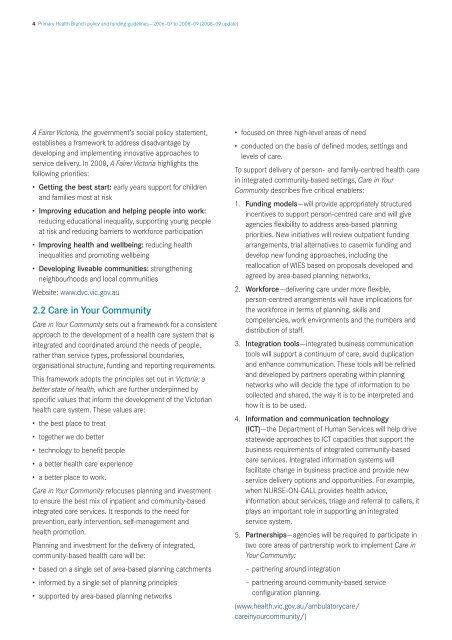Primary Health Branch policy and funding guidelines
Primary Health Branch policy and funding guidelines
Primary Health Branch policy and funding guidelines
Create successful ePaper yourself
Turn your PDF publications into a flip-book with our unique Google optimized e-Paper software.
4 <strong>Primary</strong> <strong>Health</strong> <strong>Branch</strong> <strong>policy</strong> <strong>and</strong> <strong>funding</strong> <strong>guidelines</strong>––2006–07 to 2008–09 (2008–09 update)<br />
A FairerVictoria, the government’s social <strong>policy</strong> statement,<br />
establishes a framework to address disadvantage by<br />
developing <strong>and</strong> implementing innovative approaches to<br />
service delivery. In 2008, A FairerVictoria highlights the<br />
following priorities:<br />
• Getting the best start: early years support for children<br />
<strong>and</strong> families most at risk<br />
• Improving education <strong>and</strong> helping people into work:<br />
reducing educational inequality, supporting young people<br />
at risk <strong>and</strong> reducing barriers to workforce participation<br />
• Improving health <strong>and</strong> wellbeing: reducing health<br />
inequalities <strong>and</strong> promoting wellbeing<br />
• Developing liveable communities: strengthening<br />
neighbourhoods <strong>and</strong> local communities<br />
Website: www.dvc.vic.gov.au<br />
2.2 Care in Your Community<br />
Care in Your Community sets out a framework for a consistent<br />
approach to the development of a health care system that is<br />
integrated <strong>and</strong> coordinated around the needs of people,<br />
rather than service types, professional boundaries,<br />
organisational structure, <strong>funding</strong> <strong>and</strong> reporting requirements.<br />
This framework adopts the principles set out in Victoria: a<br />
better state of health, which are further underpinned by<br />
specific values that inform the development of the Victorian<br />
health care system. These values are:<br />
• the best place to treat<br />
• together we do better<br />
• technology to benefit people<br />
• a better health care experience<br />
• a better place to work.<br />
Care in Your Community refocuses planning <strong>and</strong> investment<br />
to ensure the best mix of inpatient <strong>and</strong> community-based<br />
integrated care services. It responds to the need for<br />
prevention, early intervention, self-management <strong>and</strong><br />
health promotion.<br />
Planning <strong>and</strong> investment for the delivery of integrated,<br />
community-based health care will be:<br />
• based on a single set of area-based planning catchments<br />
• informed by a single set of planning principles<br />
• supported by area-based planning networks<br />
• focused on three high-level areas of need<br />
• conducted on the basis of defined modes, settings <strong>and</strong><br />
levels of care.<br />
To support delivery of person- <strong>and</strong> family-centred health care<br />
in integrated community-based settings, Care in Your<br />
Community describes five critical enablers:<br />
1. Funding models––will provide appropriately structured<br />
incentives to support person-centred care <strong>and</strong> will give<br />
agencies flexibility to address area-based planning<br />
priorities. New initiatives will review outpatient <strong>funding</strong><br />
arrangements, trial alternatives to casemix <strong>funding</strong> <strong>and</strong><br />
develop new <strong>funding</strong> approaches, including the<br />
reallocation of WIES based on proposals developed <strong>and</strong><br />
agreed by area-based planning networks.<br />
2. Workforce––delivering care under more flexible,<br />
person-centred arrangements will have implications for<br />
the workforce in terms of planning, skills <strong>and</strong><br />
competencies, work environments <strong>and</strong> the numbers <strong>and</strong><br />
distribution of staff.<br />
3. Integration tools––integrated business communication<br />
tools will support a continuum of care, avoid duplication<br />
<strong>and</strong> enhance communication. These tools will be refined<br />
<strong>and</strong> developed by partners operating within planning<br />
networks who will decide the type of information to be<br />
collected <strong>and</strong> shared, the way it is to be interpreted <strong>and</strong><br />
how it is to be used.<br />
4. Information <strong>and</strong> communication technology<br />
(ICT)––the Department of Human Services will help drive<br />
statewide approaches to ICT capacities that support the<br />
business requirements of integrated community-based<br />
care services. Integrated information systems will<br />
facilitate change in business practice <strong>and</strong> provide new<br />
service delivery options <strong>and</strong> opportunities. For example,<br />
when NURSE-ON-CALL provides health advice,<br />
information about services, triage <strong>and</strong> referral to callers, it<br />
plays an important role in supporting an integrated<br />
service system.<br />
5. Partnerships––agencies will be required to participate in<br />
two core areas of partnership work to implement Care in<br />
Your Community:<br />
– partnering around integration<br />
– partnering around community-based service<br />
configuration planning.<br />
(www.health.vic.gov.au/ambulatorycare/<br />
careinyourcommunity/)

















